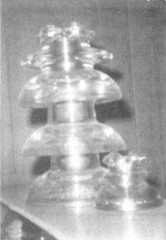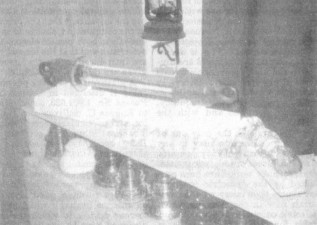A Closer Look At Corning Pyrex Insulators
by Jeff McCurty
Reprinted from "INSULATORS - Crown Jewels of the Wire", December 1977, page 4
Upon receiving a request for information on their insulators, Corning Glass
Works always seems to be most interested in helping. The Historical Resources
Department, headed by George Southworth, with the thorough research completed by
Mr. Otto Hubert, has supplied me with quite some fascinating information in
regard to their insulators. I now would like to pass it on to Crown Jewels
readers with this article.
Upon asking about their embossing practices, I was informed that Corning Glass Works refers to the embossing on their insulators
as "mould markings". The mould markings are used to identify the
electrical characteristics of the insulator and assure that the correct
insulator size is used on any given power line.
Because Corning Pyrex insulators
have such extended mould markings on each of their insulators, I asked if there
were any specific reasons why. "Pyrex" and "Corning Pyrex",
both registered trademarks of Corning, apparently indicated the origin of the
insulator's manufacture. The size of the insulator itself had something to do
with the choice of the marking. Other than this, Corning knows of no reason why
some of their insulators were marked "Pyrex" and some "Corning
Pyrex".
As to the placement of their mould markings, Corning did have
specific reasons. Many of the larger power type insulators have their markings
on the underside of the glass, reading through it. By having the letters placed
here, on the insulator skirt, it greatly improved the cleaning of the glass by
rainfall, and thus increased the electrical insulation of the unit, which was a
most desirable result. The actual location on the insulator was one of
convenience.

Certain Pyrex insulators had additional letters and dot markings
used to identify the moulds from which they were made, for mould material
control purposes. Corning has been unable to locate the record of the key to
these letters and dots
The Pyrex Stacker (with Pyrex 662 for scale), see photo,
which consists of two CD 311's supporting a CD 248, has the most extensive mould
marking of any Pyrex unit I know of. All three sections read: PYREX PAT.
5-27-19, MADE BY CORNING GLASS WORKS, CORNING, N.Y. U.S.A. Corning Glass Works
supplied the following information:
"The three part Pyrex brand insulator
assembly over a central wood post was designed for and used in a dry climate such as Colorado. The
two lower Pyrex sections consisted of a tubular sleeve combined with a drooping
skirt, topped by a standard skirted type regular Pyrex insulator which was
threaded and was screwed to the central wood post. This type of insulator
assembly was replaced by the now common suspension type assembly with three to
five or more units connected to a single string. The insulators in the multiple
strings consist of three to six or more single so-called cap and pin insulators
coupled together with metal cap and rod cemented in place."
The Corning
Glass Works has trademarks "Corning" and "Pyrex", and
patents on borosilicate glass, commonly called "Pyrex Glass". The
trademark "Pyrex" was registered July 10, 1915 and issued July 13,
1917. The Pyrex Glass Composition Patent was issued May 27, 1919. No one at
Corning has any record or recollection as to why the date was marked on the
Stacker insulator.

Corning's Radio Antenna Insulators (see photo above) include the patent #
1700066. This was for an antenna insulator to be composed of Pyrex Glass. See
Patent copy, lines 65-75. Because no specific design was issued, the patent
covers all designs of the Radio Antenna Insulator, 7", l2", and 19".
Corning states that the "REG. U.S. PAT. OFF." marking on virtually all
of their insulators refers to the Pyrex Brand Glass (T.M.) patent of May 27,
1919. See Patent copy.
One of the controversies in reports of Corning Pyrex
insulators has been dates of manufacture. Some past articles including some of
my own, have stated different dates, which may have seemed confusing. That is
because only one set of dates was stated. Corning has now supplied the following
dates of their insulator production. Corning Glass Works made: Power Line
Insulators, 1924-1925; Communication Line Insulators, 1926-1941; and Radio Wares
Insulators, 1924-1951.
|
